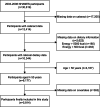Association between composite dietary antioxidant index and cataract in American adults aged ≥50 years: A cross-sectional study from NHANES 2003-2008
- PMID: 40355196
- PMCID: PMC12074027
- DOI: 10.1097/MD.0000000000042425
Association between composite dietary antioxidant index and cataract in American adults aged ≥50 years: A cross-sectional study from NHANES 2003-2008
Abstract
Oxidative stress is one of the crucial pathogeneses of cataract. The composite dietary antioxidant index (CDAI) represents the antioxidant capacity of one's diet. The aim of this study was to explore the association between the CDAI and cataract. The data were obtained from the National Health and Nutrition Examination Survey 2003 to 2008. A weighted multiple logistic regression, generalized weighted models, and smoothed fitted curves were performed to investigate the association between the CDAI and cataract. A total of 5814 participants aged ≥50 years with complete data were included in the study. According to the fully adjusted model, the odds ratio (95% confidence interval) for the association between the CDAI and cataract was 0.95 (0.93, 0.98). After dividing continuous CDAI into tertiles, consistent negative associations between CDAI and cataract were observed in the highest tertile compared to the lowest tertile (odds ratio = 0.77; 95% confidence interval, 0.62-0.95). The CDAI components (zinc, magnesium, vitamin A, and vitamin E) were also negatively associated with cataract odds in the fully adjusted model. Subgroup analysis showed inconsistent associations among subgroups, but no statistically significant interaction effects were found. This cross-sectional study revealed that a higher CDAI was associated with lower odds of cataract. These findings may contribute to cataract prevention through antioxidant dietary patterns.
Keywords: NHANES; cataract; composite dietary antioxidant index; cross-sectional study.
Copyright © 2025 the Author(s). Published by Wolters Kluwer Health, Inc.
Conflict of interest statement
The authors have no conflicts of interest to disclose.
Figures
Similar articles
-
Association between composite dietary antioxidant index and epilepsy in American population: a cross-sectional study from NHANES.BMC Public Health. 2024 Aug 17;24(1):2240. doi: 10.1186/s12889-024-19794-y. BMC Public Health. 2024. PMID: 39154181 Free PMC article.
-
Association between composite dietary antioxidant index and erectile dysfunction among American adults: a cross-sectional study.Sci Rep. 2024 Sep 11;14(1):21230. doi: 10.1038/s41598-024-72157-w. Sci Rep. 2024. PMID: 39261605 Free PMC article.
-
The association between the composite dietary antioxidant index and asthma in US children aged 3-18 years: a cross-sectional study from NHANES.Sci Rep. 2024 Jul 26;14(1):17204. doi: 10.1038/s41598-024-67702-6. Sci Rep. 2024. PMID: 39060352 Free PMC article.
-
Associations between the composite dietary antioxidant index and abdominal aortic calcification among United States adults: A cross-sectional study.JPEN J Parenter Enteral Nutr. 2024 Jul;48(5):571-579. doi: 10.1002/jpen.2638. Epub 2024 May 11. JPEN J Parenter Enteral Nutr. 2024. PMID: 38734926
-
Association between the composite dietary antioxidant index and sarcopenia among United States adults: A cross-sectional study.JPEN J Parenter Enteral Nutr. 2025 Jan;49(1):103-111. doi: 10.1002/jpen.2697. Epub 2024 Oct 27. JPEN J Parenter Enteral Nutr. 2025. PMID: 39462187
Cited by
-
Nutrient-Driven Antioxidant Interventions for Prevention of Age-Related and Diabetic Cataracts.Nutrients. 2025 May 30;17(11):1885. doi: 10.3390/nu17111885. Nutrients. 2025. PMID: 40507153 Free PMC article. Review.
References
-
- GBD 2019 Blindness and Vision Impairment Collaborators. Causes of blindness and vision impairment in 2020 and trends over 30 years, and prevalence of avoidable blindness in relation to VISION 2020: the Right to Sight: an analysis for the Global Burden of Disease Study. Lancet Global Health. 2021;9:e144–60. - PubMed
-
- Lam D, Rao SK, Ratra V, et al. . Cataract. Nat Rev Dis Primers. 2015;1:15014. - PubMed
-
- Wright ME, Mayne ST, Stolzenberg-Solomon RZ, et al. . Development of a comprehensive dietary antioxidant index and application to lung cancer risk in a cohort of male smokers. Am J Epidemiol. 2004;160:68–76. - PubMed
Publication types
MeSH terms
Substances
Grants and funding
LinkOut - more resources
Full Text Sources
Medical




